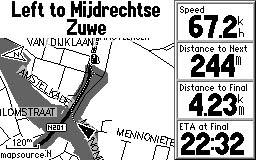hehe. fun fun fun.
no, i’m not a speed freak, but i guess it is kind of part of a motorcycle life. speed in itself has many different ‘definitions’: on an enduro even speeds below 100 kmh can be very fast, e.g. when you go down a sandy straight and most of the time the two wheels don’t seem to be sure just where they should go.
on the cross course when i shift into fourth before the jump (my favourite) i feel like shooting myself into orbit.
on a street bike there is also the pure speed component. which, frankly, i rather ignore most of the time.
well, today was ‘speed day’, then. it’s not a big deal, but for me it was, let us say, a new personal speed record. with me driving, anyway.
here it is:

seems the yamaha’s odo has about a 10% error, so this was kind of 230-240 on the yamaha. 😉
which is actually not as scary as it sounds. the bike is very, very stable. really stable. not the slightest wobble or anything. it’s just that you really got to crouch into the fairing; this is definitely beyond the comfort zone. as is anything above 200 on the odo (real world 180). up to that it is really quite ok, so i do believe that travel speeds of (real) 160 should be quite ok, even over an extended period.
also amazing is the acceleration the thing delivers: twist the trottle anywhere above 150 and you get instant response and a useful kick. and this is just an ‘sport-touring’ 600, guess what the nasty big bikes do.
well, i won’t. i think this one is really enough. there is another thing about this kind of speed. first of all it does real nasty things to fuel consumption. normally the yamaha sips something like 4.5 l/100 km, which i think is quite good. on my trip back from germany it was more like 7 l/ 100 km (avg) and i guess on the real fast legs it was closer to 9 l/ 100 km.
and what for? did i tell you that when navigating the gps displays the estimated time of arrival (eta) – see the fields on the screen shot below.

the difference between the eta calculated at the beginning of the journey and the real time of arrival was only a couple of minutes. i guess i won something like 10 minutes (on 200 km), and lost about 5 when i stopped to refuel (due to higher fuel consumption).
so all in all this is pretty useless. really.
ok, and then there is the risk. not so much the risk that something happens … more the risk what would be if something went wrong after all. if you know what i mean. sort of … the probability that you fall at that speed is not higher than at any lower speed, but if you fall … let’s just not thinkl about it.
oh, i almost forgot: the reason i went to germany in the first place was to buy a gps holder for the bike, of course. got it now. 😉
i also changed the field setup for navigation: as you see on the screen shot above i got rid of the big arrow (never could use it anyway) and replaced it with a speed reading (real world as opposed to the always rather inaccurate odos) and a ‘distance to next’. the reason for that is that on the bike i don’t hear the beep, so i need to track somehow when to look at the gps for instructions.
another thing about the gps. i must say that i was really happy with the way it got me there, given that i did not have a street level map of the area where the shop was, only the coordinates.
it also got me back really well.
the only thing that disturbes me at times is that when using the built in maps (with their inaccuracy) a simple turn off a highway can be enough to make the gps think that you are off route, and triggers a rather lengthy recalculation. this seems to go on even longer when you move (of course you do, you are on a highway).
other than that i am still very happy with the gps v, and i am looking forward to use it a lot more on the bike. still got to make the connection to the bike’s power supply, but i got the plugs already, so this is not going to take me very long.
